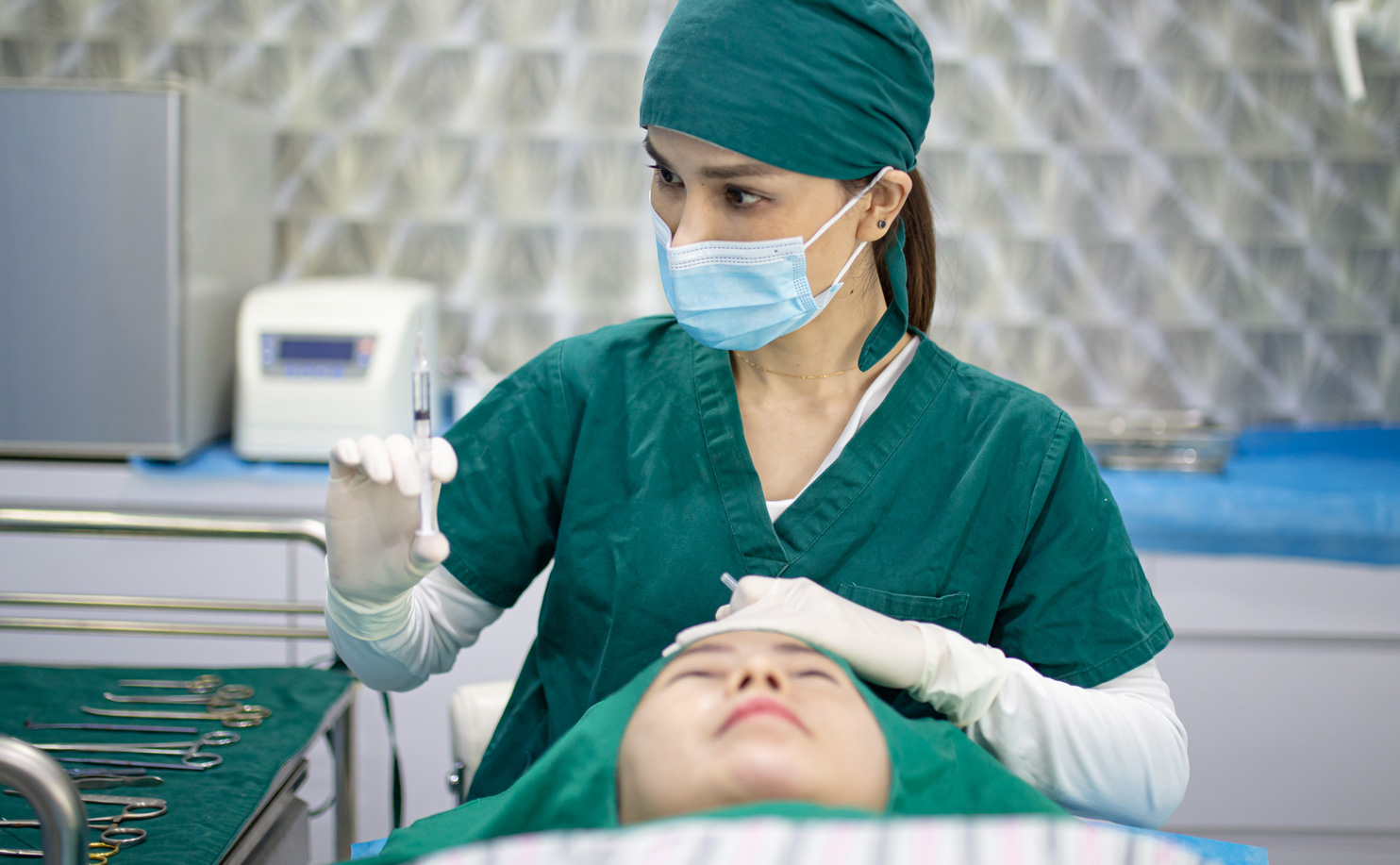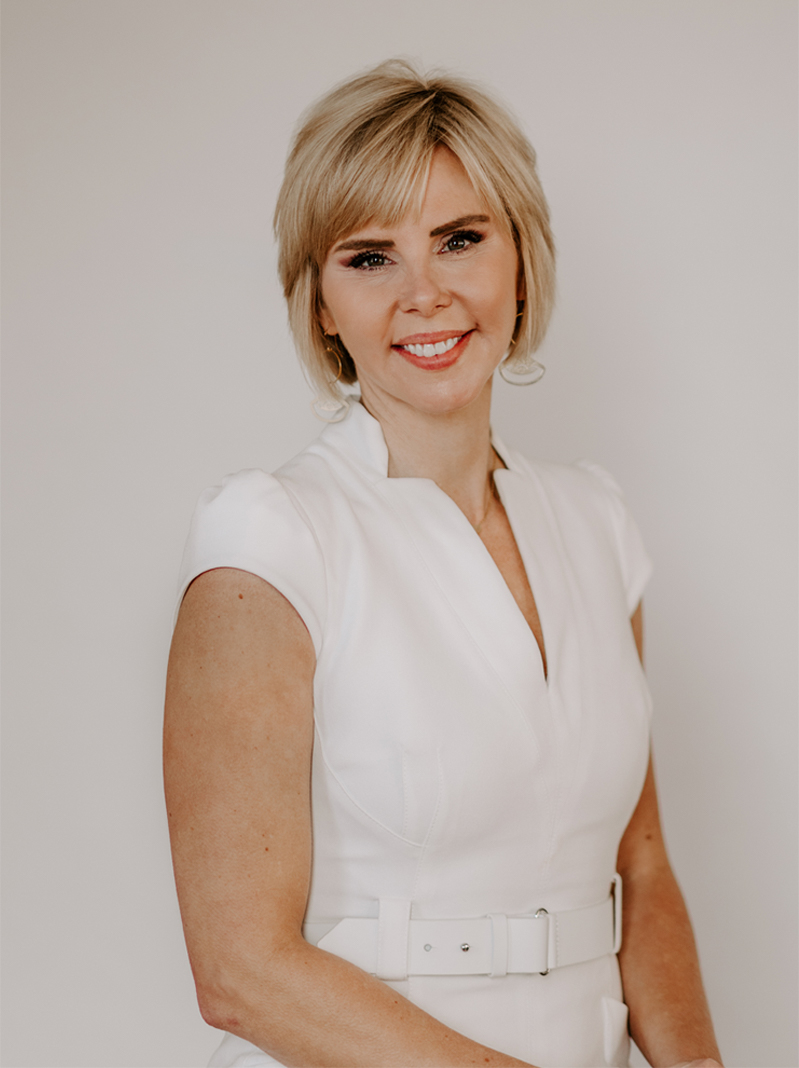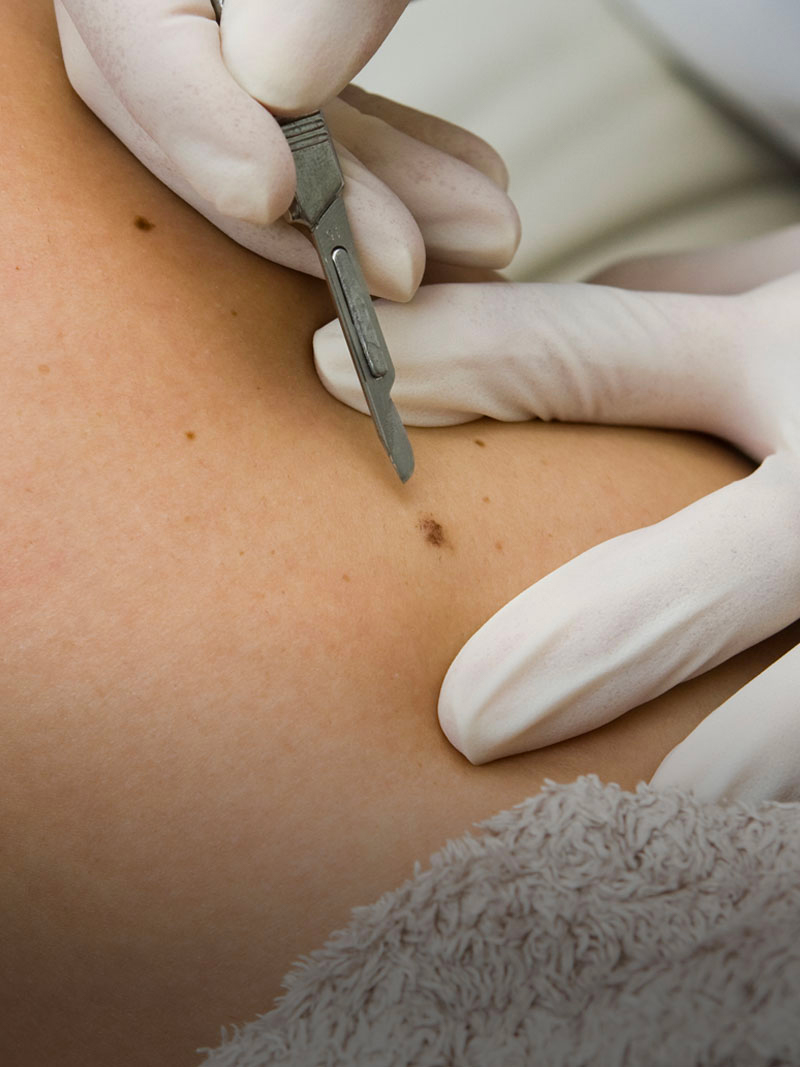


SURGICAL DERMATOLOGY
Surgery of the skin or dermatological surgery deals with the diagnosis and treatment of medically necessary and cosmetic conditions of the skin, hair, nails, veins, mucous membranes and adjacent tissues by various surgical, reconstructive, cosmetic and non-surgical methods. The purpose of skin surgery is to repair and/or improve the function and cosmetic appearance of skin tissue.
Examples of dermatological surgery procedures include treatment of skin cancers, mole removal, anti-aging treatments, injectable and implantable soft tissue fillers, botulinum toxin (Botox™) treatments, correction of acne scarring, chemical peeling, vein therapy, hair restoration, and laser surgery.
Mohs
Mohs Micrographic Surgery, an advanced treatment procedure for skin cancer, offers the highest potential for recovery, even if the skin cancer has been previously treated. This procedure is a state-of-the-art treatment in which the physician serves as surgeon, pathologist and reconstructive surgeon. It relies on the accuracy of a microscope to trace and ensure removal of skin cancer down to its roots. This procedure allows dermatologists, trained in Mohs Surgery, to see beyond the visible disease, and to precisely identify and remove the entire tumor, leaving healthy tissue unharmed. This procedure is most often used in treating two of the most common forms of skin cancer: basal cell carcinoma and squamous cell carcinoma.
The cure rate for Mohs Micrographic Surgery is the highest of all treatments for skin cancer, and is useful even if other forms of treatment have failed. This procedure, the most exact and precise method of tumor removal, minimizes the chance of regrowth and lessens the potential for scarring or disfigurement.
Additional Information
Please click here to view What to Expect on Mohs Surgery Day
Please click here to view our Wound Care Instructions
Mohs micrographic surgery, often referred to simply as Mohs surgery, is a specialized surgical technique used to treat skin cancer, particularly non-melanoma types like basal cell carcinoma and squamous cell carcinoma. The procedure is named after Dr. Frederic Mohs, who developed it in the 1930s.
How it works…
- 1. Anesthesia: The surgery begins with the administration of local anesthesia to numb the area around the cancerous growth.
- 2. Removing the Skin: The surgeon removes the visible tumor along with a thin layer of surrounding skin.
- 3. Microscopic Examination: The removed tissue is immediately processed and examined under a microscope to check for cancer cells.
- 4. Mapping: If cancerous cells are detected, the surgeon maps the area to identify where additional cancerous cells may remain.
- 5. Further Layers: The process is repeated—removing another layer of skin, examining it microscopically, and mapping—until clear margins are achieved, meaning no cancerous cells are found in the surrounding skin.
Advantages over wide local excision:
– Maximizes Skin Preservation: Mohs allows for the precise removal of cancer with minimal damage to surrounding healthy skin, which is especially important in cosmetically sensitive areas like the face.
– High Cure Rate: Mohs surgery has one of the highest cure rates for skin cancer, often exceeding 99% for basal cell carcinoma and squamous cell carcinoma.
– Immediate Results: Because the tissue is examined on the spot, patients receive immediate feedback on the status of their cancer.
Recovery: Mohs surgery varies depending on the size and location of the cancer removed. Patients might experience some swelling, redness, or discomfort, which usually subsides over time. The surgical site will heal, and Dr. Aerlyn Dawn will provide post-operative care instructions, which may include how to care for the wound and when to return for follow-up visits.
Ideal Candidates:
- 1. Cancers located on the face, ears, or other areas where cosmetic outcome is important.
- 2. Large cancers or those that have recurred after previous treatment.
- 3. Tumors with unclear borders.
Considerations: While Mohs surgery is highly effective, it requires a Board Certified Mohs surgeon. While Dr. Dawn is extensively trained to make the surgical scar almost invisible, there is no scarless surgery.
To that end, Frederick Dermatology Associates has added in Gentle Cure in 2025 in order to allow patients a non-surgical option to treat basal cell and squamous cell without surgery and possibly less scarring for removal of basal cell and squamous cell skin cancers. While Gentle Cure requires more treatments, there is no surgery, less potential for scarring, but it does require more treatments
In summary, Mohs micrographic surgery is a precise and effective method for treating skin cancer, allowing for complete removal while preserving healthy tissue. If you or someone you know is facing skin cancer, this surgery may be something worth considering and Dr. Aerlyn Dawn is one of the best Mohs surgeons available.
Interested in learning more about this procedure? Contact us today for more information.
Tell us a little about yourself. A member from our Concierge Team will get back to you shortly with next steps, and a plan of action.
FREQUENTLY ASKED QUESTIONS
What is Mohs Surgery?
What is the Difference Between Mohs Surgery and Image Guided Superficial Radiation (Gentle Cure)?
Surgical Removal: In Mohs surgery, a surgeon removes the cancerous skin and a thin layer of surrounding tissue. Each layer is examined during the procedure to ensure complete cancer removal.
- Immediate Results: Patients find out right away if the cancer has been entirely excised.
- Tissue Preservation: Mohs aims to remove as little surrounding healthy tissue as possible, which is especially important for cosmetic areas.
Advantages:
- High Cure Rate/ Very effective with a high cure rate.
- Precision: Ideal for complex cases, such as aggressive tumors or those in cosmetically sensitive areas.
- Immediate Feedback: The ability to confirm if the cancer has been fully removed in real time.
Image-Guided Superficial Radiation Therapy (IGSRT) aka Gentle Cure:
Is superficial radiation treatment: Instead of cutting out the cancer, IGSRT uses targeted radiation to destroy cancer cells. This is a non-invasive option that directs radiation precisely to the tumor site.
- Multiple Sessions: Treatment typically involves several sessions over a set period, with each session lasting a short time. Most patients require 20 treatments. This usually requires patients coming three times a week. Each appointment is relatively short and you will be in the office about 15 minutes.
Advantages to Gentle Cure:
- Non-Invasive: Ideal for patients who may not be surgical candidates due to health issues or who prefer to avoid surgery.
- Minimal Downtime: Less recovery time compared to surgery as it does not involve cutting into the skin.
- Good for Surface Cancers: Effective for superficial skin cancers, especially in areas where surgery may lead to significant scarring.
Key Differences between Mohs surgery and Gentle Cure
1. Invasiveness: Mohs surgery is invasive, while IGSRT is non-invasive.
2. Immediate Feedback: Mohs surgery provides immediate results regarding cancer removal, whereas IGSRT requires multiple sessions and time for the skin to heal.
3. Recovery Time: Mohs usually involves more recovery time due to surgical intervention, while IGSRT generally has minimal downtime.
4. Effectiveness: While both treatments can be effective, Mohs is maybe preferred for highly aggressive non-melanoma skin cancers. A consultation should be done to decide which approach is best for you given the histology from the initial diagnostic biopsy.
Conclusion: Choosing between Mohs surgery and image-guided superficial radiation therapy depends on several factors, including the type and location of the skin cancer, patient health, and personal preferences.
Insurance generally covers both. We can help you determine your patient responsibility if deciding between treatment options.
To learn more about Gentle Cure, please click here.
Do You Have a Video Example of Mohs Surgery?
Who Performs Mohs Surgery?
What are the Advantages of Mohs Surgery?
I Don’t See Anything After My Biopsy. Does It Really Need Treatment?
Why Does My Cancer Need Mohs Surgery?
How is Mohs Surgery Performed?
What are the Risks of Mohs Surgery?
Bleeding: Though more extensive bleeding is possible, minor bleeding after surgery is common and is usually easily controlled.
Pain: During surgery, pain is limited to the initial needles used for local anesthesia. Following surgery, most patients experience minor discomfort which can be controlled by extra strength Tylenol and icing.
Infection: Infection following surgery is possible but uncommon. If an area does become infected, it can usually be treated with oral antibiotics.
Nerve Damage: Numbness or tingling around the surgical site is common and usually gradually resolves over time. Occasionally, your skin cancer may be located near a larger sensory nerve or a nerve that connects to a muscle. If such a nerve is damaged, permanent numbness or impaired muscle movement is possible.
Recurrence: Mohs surgery offers the highest cure rate of all skin cancer treatments (98% to 99% for most tumors). However, no treatment can guarantee that the tumor will not grow back. Rarely, a tumor may reappear within the treated area.
How Large Will the Wound Be?
How Will the Wound be Repaired?
Will I Have Stitches?
Linear Closure: Most wounds are sutured closed in a linear fashion. Depending on the location, sutures are typically removed 1 to 2 weeks after Mohs surgery.
Flap: Flap reconstruction allows us to repair complicated wounds by taking advantage of more flexible nearby tissue and sliding or rearranging it to repair your wound.
Skin Graft: In some instances, most commonly on the nose or ears or for very large wounds, it is necessary to harvest skin from another location as a skin graft to repair your wound.
Second Intention Healing: The body has an excellent capacity to heal open wounds in some locations. We most commonly consider second intention healing for wounds on the scalp or legs. These wounds may take 2 to 4 months to heal depending on the location, size, and depth of the wound. Second intention wounds requires daily wound care and complicated wound sometimes require referral to a local wound care center to aid healing.
How Long Will Mohs Surgery Take?
Can a Family Member Stay with Me During My Surgery?
Will I Need Follow Up Visits?
How Should I Prepare for Surgery?
Should I Take My Anti-Anxiety Medication?
Should I Take My Regular Medications?
Can I Drink Alcohol Before Mohs Surgery?
Can I Eat Before Mohs surgery?
What Restrictions Will I Have After Surgery?
* Do NOT drink alcohol for 48 hours after surgery. Alcohol increases your risk of bleeding.
* Do NOT smoke during your healing after surgery. Cigarette smoking constricts blood vessels, impairs wound healing, and can sometimes cause failure of the surgical reconstruction.
What Will My Scar Look Like?
Do I Need to See a Plastic Surgeon?
What Should I Expect After Surgery?
Do I need to Have Someone Drive Me?
How Long Does it Take to Heal After Mohs Surgery?

WELCOME TO FREDERICK, MD
Frederick Dermatology Associates has put Frederick, MD on the map as a regional authority on skin health and wellness. With an emphasis on building a natural, refreshed look in our patients, we focus on innovations in cosmetic, medical and aesthetic dermatology, backed by experience and supervision by our board-certified dermatologists. Whether you’re local or out of town, consider Frederick, MD as your destination for excellence in dermatology.
A PATIENT-FIRST APPROACH
GET THE MOST OUT OF YOUR FDA EXPERIENCE!
Introducing the Frederick Dermatology Associates Loyalty Program! Remember to get your loyalty card stamped for products and services purchased to earn your way to a free Aura brand product (some conditions apply).
LOOKING FOR DEALS?
Sign up to be added to our email list to receive exclusive promotional offers on all of our body shaping services.


